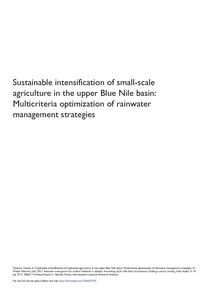Resource information
Using a multi-criteria optimization technique for system analysis, this paper quantitatively characterizes baseline production activities, resource management and environmental relationships of the mixed crop–livestock farming system at the Jaba micro-watershed, upper Blue Nile Basin, to get insights that inform sustainable intensification of small-scale agriculture. The paper characterizes and models system relationships at a landscape scale under the business as usual land use and resource management scenario (including rainwater management), in the light of social, economic and environmental sustainability indicators (employment, farm income and sediment loss and water generation, respectively). The analysis is based on optimization technique that weighs the socio-economic and environmental costs and benefits of current land use and resource management practices at spatial and temporal scales, using farm level survey data. The results show that, under the business as usual scenario, the crop sub-sector will remain the major source of farm income and rural employment. Agricultural income, though trending positively, will not significantly drift from its current level, indicating the limited possibility for rural income growth from agricultural activities under the current pattern of land use, resource management and socio-economic circumstances. Land has the highest shadow price (while such price is low for labour), showing that land scarcity, unlike abundant labour, limits the possibility for extensive farming and agricultural income growth in the area. The environmental cost of agricultural income growth is considerable, showing a clear trade-off between agricultural income growth and the natural resource base that supports agriculture. The socio-economic and biophysical consequences of alternative innovations towards such end can be simulated by introducing respective scenarios into the quantified baseline relationships. The social, economic and environmental consequences of alternative rainwater management strategies can be simulated for technology selection, prioritization and targeting.


